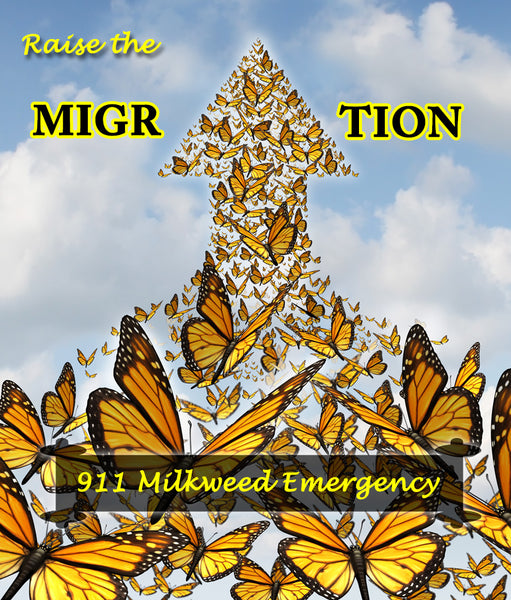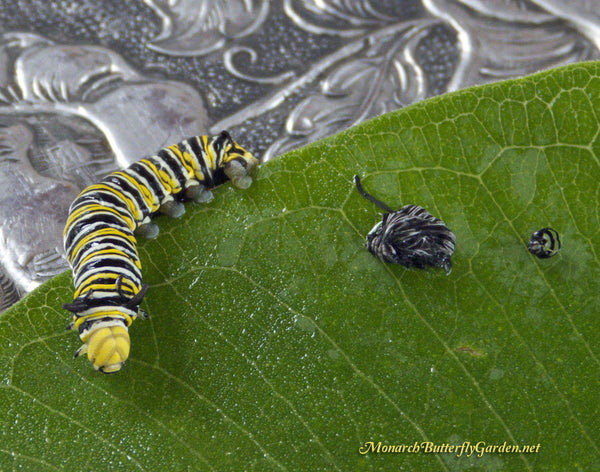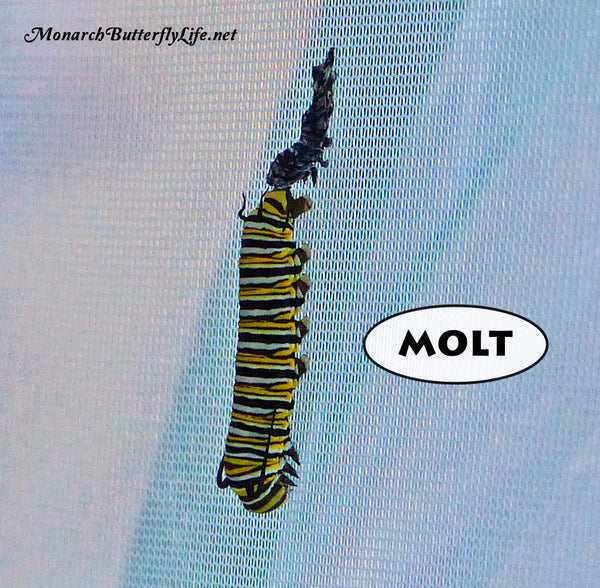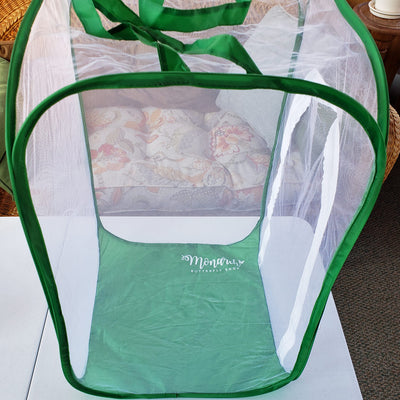Raising Butterflies Blog
911 Milkweed Emergency + Raising Tips for Large Monarch Caterpillars

Raising Big Cats and Milkweed Emergencies

Your monarch caterpillars will grow in size roughly 2000% from the day they hatch until the time they form their chrysalides…from 2mm to almost 2 inches!
To accommodate this rapid growth to large monarch larvae, they need to shed their skin (molt) 5 times, with the final molt revealing their emerald green chrysalises.
Each of these molts grows the monarch caterpillar to its next instar (period of development): Caterpillar Life Cycle Instar Info and Photos <<< click link

Before they molt, your cats might crawl to find the perfect molting spot. Top molting destinations include under milkweed plant leaves, cage walls, floral tubes, and under the rim of container plants.
Don’t be alarmed if they stay there for 24-48 hours.
This is normal behavior and they will usually molt (and return to fresh milkweed) without any assistance. If you’re worried they’re lost in space, position milkweed close to the molting spot and have leaves touching a mesh wall so it’s easier to find when they start crawling again.
After a molt, they will often feast on their shedded, nutrition-laced skins, leaving behind just the face cap.
Here is what a molting caterpillar looks like in action:
Monarch Caterpillar Molting Videos

911 MILKWEED EMERGENCY

The most important thing to keep in mind about larger caterpillars (instar 3 to instar 5) is that they can eat you out of garden and home.
Instar 3 monarch caterpillars measure up to a half-inch in length.
The first time I ran out of milkweed I was shocked at how much those little pigerpillars had scarfed down in just 12 short hours.🐽
Many seasoned raisers remember what it’s like running out of milkweed for the first time…the sheer panic that sets in when you’re not sure where your caterpillars’ next meal will come from.
Relax, take a deep breath, and consider these 9 options:
- Do you grow other species of milkweed? Caterpillars can easily switch between milkweed varieties. The only problems I’ve heard reported are when people try to switch caterpillars to Asclepias tuberosa (butterfly weed). We regularly switch between common, swamp, and tropical.
- Do your neighbors grow milkweed for monarchs?
- Is there a local park where milkweed grows wild?
- Does a local nursery sell milkweed plants? (If yes, make sure no pesticides were used on the plants or it will kill your caterpillars!)
- Call a local university with an entomology or wildlife biology program for guidance.
- Post in a facebook group to see if you can find someone in your area with spare milkweed.
- Secret Stash? Milkweed leaves can be preserved for future use by storing them in plastic bags or food containers inside the refrigerator.
- Check out our suggested milkweed stores to see if a vendor has plants they can ship quickly.
- Instar 4-5 caterpillars (over a half-inch long) have been reported to eat pieces of butternut squash, delicata squash, pumpkin, crunchy cucumber, and watermelon slices. I have seen/heard people have the most success with the squash varieties.
Keep in mind, feeding caterpillars with alternative foods could have unknown consequences for their development (including lack of poisonous toxins to deter predators) and should be used as a last resort.
If your milkweed supply isn’t an issue, having more inside the cage is always better. As long as you keep large cats fed and their habitat clean, things usually turn out fine.
Stick to raising limits and you’re also less likely to be faced with caterpillar death and disease. 🐛☠️ ☹️
However, this is the period when diseases and parasites can start to rear their ugly heads, so keep a close eye on your caterpillar cage guests. 🐛🔍
I hope this info helps your large monarch caterpillars thrive. For further assistance raising healthy butterflies through the monarch life cycle, our ✬✬✬✬✬ rated How To Raise More Monarchs, with Less Effort book is available for purchase HERE <<< (choose paperback or PDF download)













